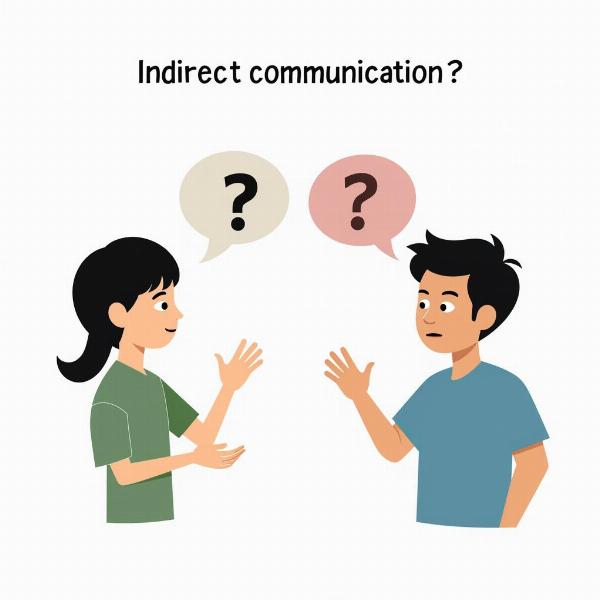Understanding the nuances of “indirectly” and its Hindi equivalents is crucial for effective communication. Whether you’re translating documents, having a casual conversation, or delving into Hindi literature, grasping this concept will enhance your understanding and fluency. This article explores the various ways to express “indirectly” in Hindi, considering different contexts and cultural implications.
Exploring the Hindi Translations of “Indirectly”
“Indirectly” in Hindi can be translated in several ways, each with its own subtle shades of meaning. Some common translations include:
- अप्रत्यक्ष रूप से (apratyaksh roop se): This is the most literal translation and emphasizes the lack of directness. It’s suitable for formal and technical contexts.
- परोक्ष रूप से (paroksh roop se): Similar to “apratyaksh roop se,” this term also highlights the indirect nature of an action or statement. It’s often used in philosophical and literary discussions.
- घुमा फिरा कर (ghuma phira kar): This phrase literally means “going around in circles” and implies a roundabout or evasive approach. It’s often used in informal conversations.
- इशारों इशारों में (ishaaron ishaaron mein): This expression translates to “through hints” or “by suggestion.” It describes communication that relies on subtle cues rather than explicit statements.
- बातों बातों में (baaton baaton mein): This phrase signifies “in the course of conversation” and suggests that something was conveyed indirectly during a casual exchange.
 Indirect Communication in Hindi
Indirect Communication in Hindi
Choosing the Right Hindi Equivalent
The best Hindi translation for “indirectly” depends heavily on the specific context. For instance, in legal documents, “apratyaksh roop se” would be appropriate, while “ghuma phira kar” might be suitable for everyday conversations. Understanding these nuances is essential for accurate and effective communication.
Formal vs. Informal Contexts
In formal settings like business meetings or academic presentations, using “apratyaksh roop se” or “paroksh roop se” conveys professionalism and precision. However, in informal conversations with friends or family, “ghuma phira kar” or “baaton baaton mein” feels more natural and relatable.
Indirect Communication in Indian Culture
Indian culture often favors indirect communication, particularly when dealing with sensitive topics or expressing disagreement. This cultural preference stems from a desire to maintain harmony and avoid direct confrontation. Understanding this cultural context is vital for navigating social interactions effectively.
Examples of Indirect Communication
Imagine someone asking for a favor. Instead of directly saying “I need your help,” they might say, “I’m in a bit of a situation.” This indirect approach allows the other person to offer help without feeling pressured.
Why is Understanding “Indirectly” Important?
Mastering the various ways to express “indirectly” in Hindi is vital for several reasons:
- Accurate Translation: Choosing the correct equivalent ensures the intended meaning is conveyed precisely.
- Effective Communication: Using the appropriate phrase enhances clarity and avoids misunderstandings.
- Cultural Sensitivity: Understanding the cultural nuances of indirect communication fosters respectful interactions.
Conclusion
“Indirectly meaning in hindi” encompasses a range of expressions, each with subtle differences in meaning and usage. By understanding these nuances and the cultural context of indirect communication, you can enhance your Hindi language skills and navigate social interactions effectively.
FAQ
-
What is the most common Hindi translation for “indirectly”? Apratyaksh roop se (अप्रत्यक्ष रूप से) is the most common and literal translation.
-
When should I use “ghuma phira kar”? This phrase is suitable for informal conversations when implying a roundabout approach.
-
Why is indirect communication common in Indian culture? It’s often preferred to maintain harmony and avoid direct confrontation.
-
How can I improve my understanding of indirect communication in Hindi? Immersing yourself in Hindi conversations and observing social interactions can help.
-
Is it always necessary to be indirect in Hindi communication? No, direct communication is appropriate in certain contexts, especially formal or professional settings.
Meaning-Hindi.in is your trusted partner for all your Hindi translation needs. We offer a wide range of specialized translation services, from business and legal documents to technical manuals and website localization. Our team of expert linguists ensures accurate and culturally sensitive translations. Contact us today at [email protected] or +91 11-4502-7584 to discuss your project requirements. Meaning-Hindi.in is committed to providing high-quality, reliable translation services tailored to your specific needs.